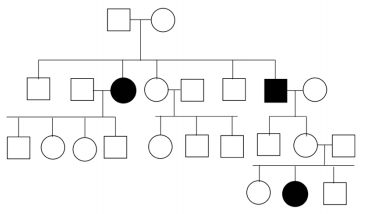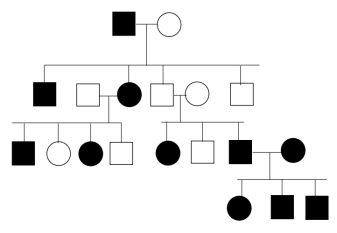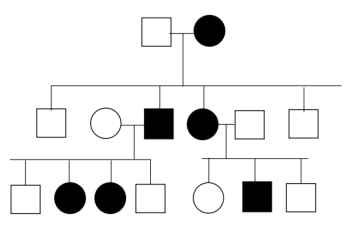Okay. So now we're going to go over various autosomal pedigrees. So autosomal means anything that is not on a sex chromosome. So autosomal mutations or autosomal alleles, they're all going to be on chromosomes that are not sex chromosomes. So they're going to be inherited in an autosomal fashion. So the first type of autosomal inheritance that we're going to talk about is autosomal recessive disorders. So autosomal means not on a sex chromosome, and recessive means that in order to have the phenotype, you're going to need 2 recessive alleles.
Here's an example of an autosomal recessive pedigree, and I'll disappear so you can see it. And when you look at this pedigree, I want you to be able to identify that this is autosomal recessive. So the way to do that, I've given you a few hints here. The first thing is you want to look at how many children come from affected or unaffected parents. In autosomal recessive disorders, what you're going to see is that there are affected individuals, so fully recessive individuals that appear in the offspring of unaffected parents. Right? So they at least have one dominant allele. And so, what we see here is that if we look at some unaffected parents, we can see that offspring are produced from unaffected parents. Right? Again, this happens again down here, where we have an affected individual and 2 unaffected parents. That's the first thing that starts suggesting this might be recessive.
The second thing that shows us that it's probably autosomal is that the affected offspring occur in both males and females. If you start seeing more males or more females, we start thinking that this might actually be a sex-linked inheritance. But if it's pretty much males and females equally, then it is likely to be autosomal. So if we look here, we can see that we have both females and males that are affected. And although there's not a lot of affected, so it's hard to tell whether it's equal, we still can see that there are both males and females are affected, so it's likely autosomal.
The third thing that suggests recessive is that there are only a few affected offspring. So looking at all of the people in this one family, there are only 3 out of several that actually have the disease, and so that's suggesting recessive. So autosomal recessive disorders, they're going to have affected individuals that show up in unaffected parents. It's going to be males and females almost equally, and there's only really going to be a few that show up, in an entire family.
Now, let's go and move on to autosomal dominant. Now, autosomal dominant is going to be a disorder that's caused from a mutation, on an autosome, so not a sex chromosome, and it's going to be a dominant allele. So it's going to be an uppercase letter. Now, how we can tell this is through these little cheat sheets here. The first thing is that the phenotype is going to appear in every generation. This suggests dominance. Right? Because anytime you get one dominant allele, that person is going to express the phenotype. It's going to have the disease. Whereas, in autosomal recessive, you actually have to have 2 recessive alleles in order to have that phenotype. So, dominance in a family is going to appear much more often than a recessive.
Now, if we have an affected parent, we're going to have affected children. If you have more than 1 child, you're going to start seeing affected children. So affected parents are going to pass it to their children, and we're also going to see it equally in males and females, which is not written here, but we're saying males are equal to females. This suggests autosomal. And then one really unique part of this is because when we think dominant, we always think common. Right? We say something, oh, that trait must be dominant because everyone has brown hair. It's sort of this ingrained thing that you didn't actually learn, but you just think it's like that. But in autosomal dominant disorders, it's actually different because autosomal dominant disorders are rare.
Now you may ask, how in the world is a dominant disorder rare? Well, it is if you have the uppercase r allele, the uppercase dominant allele, then you're going to express that. But this allele can be really rare in the population. So if you look at one individual family with this allele, you're going to see that a lot of the people in that family are affected because it's a dominant disorder. But, if you look at 20 families or 100 families or an entire population of families, you're going to find that that allele is not present. It's very rare. It's very rarely present in any family. But if it is present, then you're going to see it a lot. So, autosomal dominant disorders are dominant, but they're actually rare in the population as a whole.
So here, if we're looking at an autosomal dominant, what we can see is that affected parents have affected children. We can also see that it's pretty equally distributed among males and females. There are 3 males and 3 females here. We can see, we actually can't see that it's rare in the population because if we look here, we're just looking at one family and it looks really common. But, usually, in questions like this, they'll say, oh, this extremely rare disease shows up in this family. And, if it were really that rare and autosomal recessive, we would only see it in a couple of people in the family. But, if it's rare and dominant, then we see it looks like this.
And that's an important distinction to make because there's a third type of pedigree I want you to know about, and this is called autosomal polymorphism. Now, polymorphism means that there are 2 or more common phenotypes of a trait. So a good example of this is tasters or supertasters. There are people in the world that have more sensitive taste buds than others, and it's actually fairly evenly divided. And you can test this through this little test where you put a piece of paper on your tongue, and if you taste it, you're a supertaster, and if you don't taste it, then you're just a normal taster. Now, polymorphisms, it's not a mutation, it's not a disease. It's just a phenotype. Some people taste it, some people don't, and that's okay. And these traits are inherited in a normal Mendelian manner, and there's a lot of different ones. There's attached and free earlobes, there are widow's peaks, and this is the super tasters. They're just really common traits that you can have or you don't have it. It's not a big deal. It's not a disease. But autosomal polymorphisms are really common and they look really similar to an autosomal dominant pedigree.
So if we are looking here, this is a pedigree for supertasters, where if you don't taste it, you're recessive, recessive, so and you're black. And if you do taste it, you're in white, and you're dominant. And we can see that if we look here, we have an equal, about equal number of males and females. We see that it's in every generation. So, automatically looking at this, I'm thinking autosomal dominant. But the way that I can tell the difference between autosomal polymorphism and autosomal dominant is that in the question you're given, an autosomal dominant disease is going to be rare in the population. So autosomal dominant equals rare in population, but common in a family. Because here we see it's very common in this family. It's pretty much in every generation, but it's rare in the population as a whole. An autosomal polymorphism is going to be different because it's going to be common in the population and common in the family.
Now, most of the time, you won't get a question about telling the difference between an autosomal dominant and an autosomal polymorphism. This would be a fairly advanced question, but I did want to include it just in case your professor decides to go over it. But most of the time, what you'll be comparing is is this an autosomal recessive or is this an autosomal dominant. And the way that you can tell that is looking through those cheat sheets that I provided above and will provide a really great flowchart at the end of this so that you can easily tell apart which pedigree is which. So those are the autosomal pedigrees. With that, let's move on.




